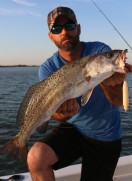The Sheepshead push is going strong in the St. Johns Inlet. The first waves are smaller fish around 2-3 pounds on average with several from 3-5 pounds mixed in. Angler beware though, the Black Tips are taxing the heck out of us on the tips of the jetties right now. Especially on the tip of the South row. One day in particular, we lost 10 Sheepshead to the Sharks. If you can't get them to the boat fast, you'll get taxed, HARD! That day we were hit with around 40% taxes
I won't delve too much into the rigging and technique so much in this report. I went into detail on those aspects in my last report. Revert back to http://forums.floridasportsman.com/s...Fish-and-Trout for additional information if I fail to answer a question you may have about those topics.
Today I want to touch on "reading the Inlet". The Inlet rocks can all look the same if you don't know what to look for but trust me, there are vast benefits choosing one rocky bottom vs another. Tide and water clarity are one thing but, there are other contributing factors that can make certain areas stand out more so than others.
On rough days for example, I like fishing the churned waters on the back tide of any rock pile or point that is getting pounded. All that turbulence created from the continuous waves breaking through the granite boulders releases crustaceans that would normally remain concealed in the cracks between the stones. The Sheepshead will be at the base of the wall picking them off as they fall. The other benefit of this situation is that with all that crashing, the water along the rocks becomes heavily oxygenated. with more o2 in the water, the fish don't have to work as hard to breath, reducing the energy needed to feed. A win win.
Another thing to consider when selecting a spot to fish are "tide eddies". Just like any other fish, Sheepshead prefer to be just outside heavily moving water. You'll often find them just off the edge of any rocky point with heavy current just off to the side. They'll sit there and pick off crustaceans as they pass by.
There are a number of less obvious eddies dotting the rock lines that people pass by unknowingly. At higher tides, the lower areas in the wall act as eddies. The fish will sit just under the walls surface on the side adjacent to the current. The current passes just overhead and they pick off forage as it flushes through.
Another thing to look for are "doglegs" in the rock line. The jetty rows aren't perfectly straight and often there are short bends or "Doglegs" for a lack of a better term... Where the rocks turn, an eddie is formed. These are good areas to fish, especially when currents are nuts like during Spring Tides or Full Moon tides. My trolling motor batteries appreciate them as well. I can situate my boat just off the point of a dogleg and the current will be just calm enough to spotlock without having to run at higher speeds. The same principle applies when fishing the opposing side of the jetty tips on an outgoing tide.
That's it for today fellas. Get out there and take advantage of the Fall Sheepshead action.
Florida inshore charter fishing. Jacksonville fishing charters. Mayport fishing charters





admin
Danny Pardue